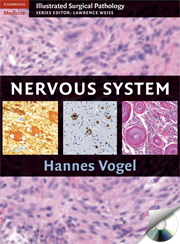Book contents
- Frontmatter
- Contents
- Contributors
- Preface
- Acknowledgments
- 1 Normal Anatomy and Histology of the CNS
- 2 Intraoperative Consultation
- 3 Brain Tumors
- Brain Tumors – An Overview
- Brain Tumor Locations with Respect to Age
- Grading Brain Tumors
- NEUROEPITHELIAL
- TUMORS OF CRANIAL AND PARASPINAL NERVES
- TUMORS OF THE MENINGES
- LYMPHOMAS AND HEMATOPOIETIC NEOPLASMS
- GERM CELL TUMORS
- NONNEOPLASTIC MASSES AND CYSTS
- PATHOLOGY OF THE SELLAR REGION
- METASTATIC NEOPLASMS OF THE CENTRAL NERVOUS SYSTEM
- SKULL AND PARASPINAL NEOPLASMS, NONNEOPLASTIC MASSES, AND MALFORMATIONS
- CNS-RELATED SOFT TISSUE TUMORS
- 4 Vascular and Hemorrhagic Lesions
- 5 Infections of the CNS
- 6 Inflammatory Diseases
- 7 Surgical Neuropathology of Epilepsy
- 8 Cytopathology of Cerebrospinal Fluid
- Index
NEUROEPITHELIAL
from 3 - Brain Tumors
Published online by Cambridge University Press: 04 August 2010
- Frontmatter
- Contents
- Contributors
- Preface
- Acknowledgments
- 1 Normal Anatomy and Histology of the CNS
- 2 Intraoperative Consultation
- 3 Brain Tumors
- Brain Tumors – An Overview
- Brain Tumor Locations with Respect to Age
- Grading Brain Tumors
- NEUROEPITHELIAL
- TUMORS OF CRANIAL AND PARASPINAL NERVES
- TUMORS OF THE MENINGES
- LYMPHOMAS AND HEMATOPOIETIC NEOPLASMS
- GERM CELL TUMORS
- NONNEOPLASTIC MASSES AND CYSTS
- PATHOLOGY OF THE SELLAR REGION
- METASTATIC NEOPLASMS OF THE CENTRAL NERVOUS SYSTEM
- SKULL AND PARASPINAL NEOPLASMS, NONNEOPLASTIC MASSES, AND MALFORMATIONS
- CNS-RELATED SOFT TISSUE TUMORS
- 4 Vascular and Hemorrhagic Lesions
- 5 Infections of the CNS
- 6 Inflammatory Diseases
- 7 Surgical Neuropathology of Epilepsy
- 8 Cytopathology of Cerebrospinal Fluid
- Index
Summary
Astrocytic Tumors
Astrocytoma is the general term applied to a diversity of glial tumors spanning WHO Grades I–IV showing cellular features of astrocytes. The subtypes are classified according to their similarity to certain nonneoplastic astrocytes, most commonly fibrillary, occasionally gemistocytic, and rarely protoplasmic. It is essential to recognize the similarities and differences, particularly in nuclear size and morphology between nonneoplastic cells and their neoplastic counterparts.
As with almost all gliomas, a fibrillary background is highly characteristic of astrocytomas, particularly conspicuous in cytological smear preparations as well as in histological sections. When a fibrillary background is absent, an alternative diagnosis should be seriously considered, particularly of lymphoma ormetastatic tumor.
The accurate grading of astrocytomas, as in all glial neoplasia, is of paramount importance in assigning the appropriate therapy and prognosis. Grading based strictly upon histological features has been somewhat augmented by molecular and genetic markers (Louis and International Agency for Research on Cancer, 2007). WHO Grade I astrocytomas comprise a very special group within gliomas since they are associated with a distinctly better prognosis over WHO Grade II–IV astrocytomas, and the pilocytic astrocytoma exemplifies this group best. Higher grades are assigned based upon the additive criteria of
nuclear atypia (WHO Grade II)
conspicuous mitotic activity (WHO Grade III), and
vascular proliferation and/or necrosis (WHO Grade IV).
- Type
- Chapter
- Information
- Nervous System , pp. 37 - 180Publisher: Cambridge University PressPrint publication year: 2009

